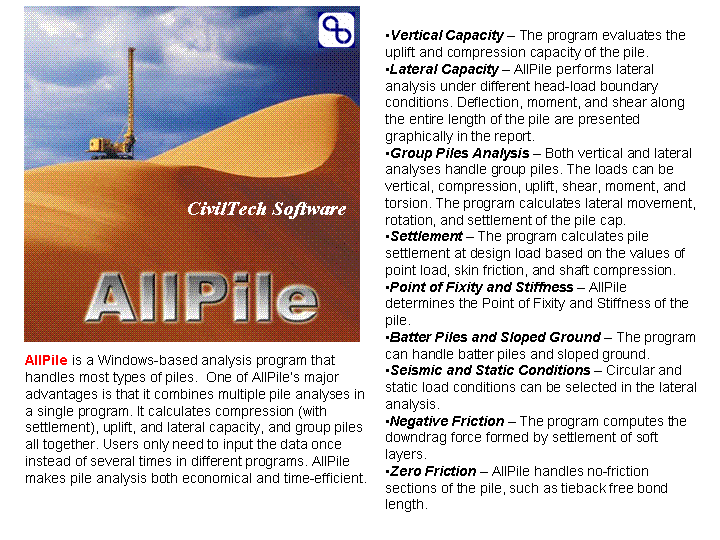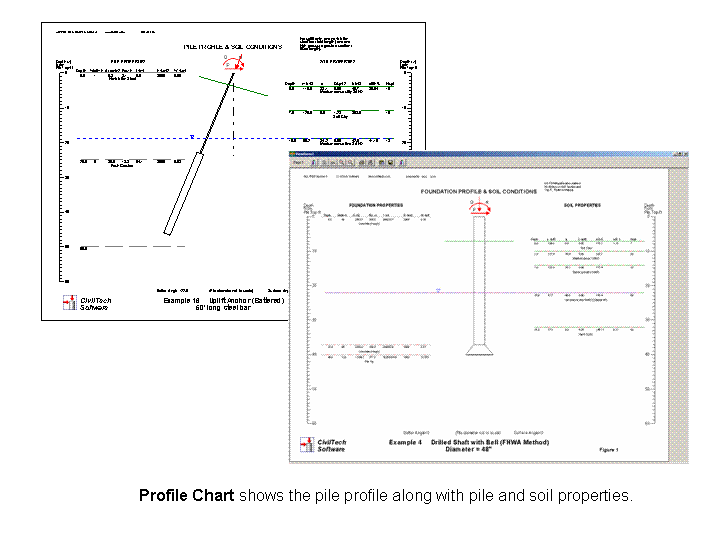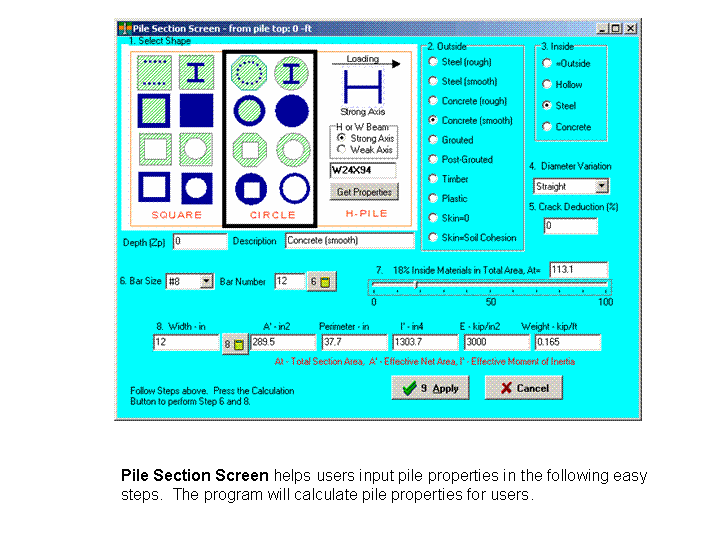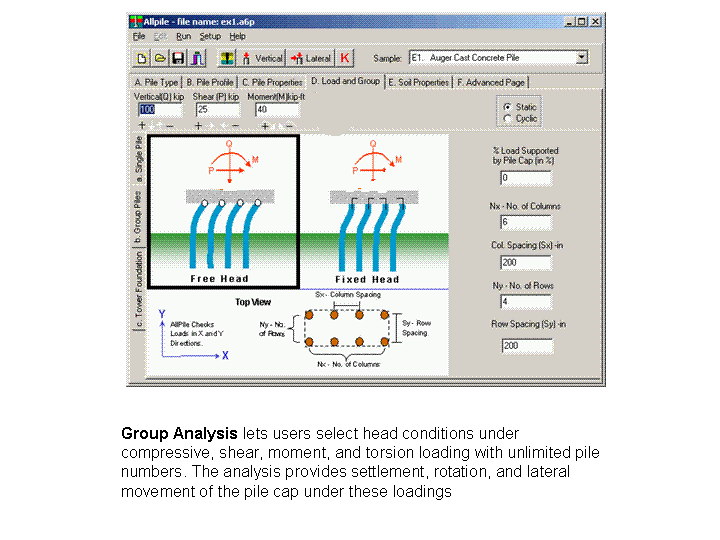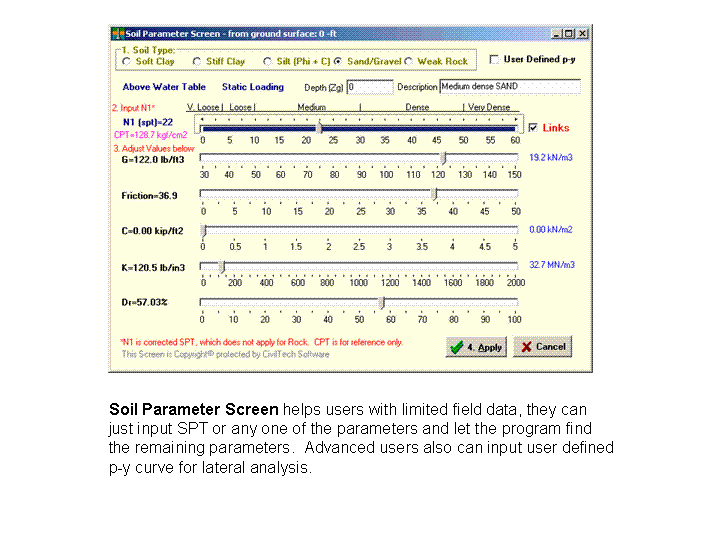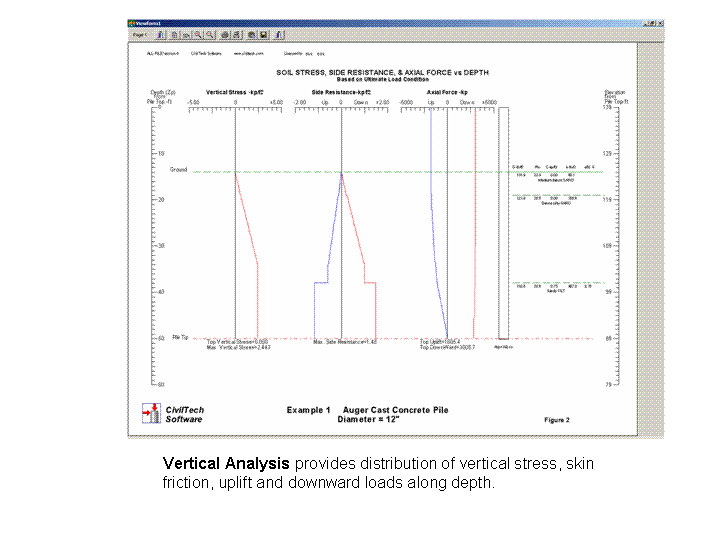AllPile is a Windows-based analysis program that handles virtually all types of piles, including steel pipes, H-piles, pre-cast concrete piles, auger-cast piles, drilled shafts, timber piles, jetted piles, tapered piles, piers with bell, micropiles (minipiles), screw/helical piles, uplift anchors, uplift plate, and shallow foundations.
We are now offering online licenses for Allpile. Click to learn more.
Ready to purchase? Visit the order form
One of the major advantages AllPile has over other pile software is that it combines most pile analysis in a single program. It calculates compression (with settlement), uplift, lateral capacity, and group analysis all together. Users only need to input the data once instead of several times in different programs. AllPile makes pile analysis easy, economical, and time-efficient.
AllPile is suitable for all engineers, even those without too much pile analysis experience. It helps structural engineers choose soil parameters, and geotechnical engineers choose pile properties. AllPile is a must-have tool for structural, geotechnical, and construction engineers.
Calculation Method
- Vertical analysis is based on the approaches and methods recommended in FHWA, AASHTO, and NAVY DM-7 (NAVFAC) manuals. The compression capacity is the combination of skin friction and tip resistance. The uplift capacity is the sum of skin friction and pile weight. The torsion capacity is the sum of horizontal skin friction around the shaft.
- Lateral analysis uses the finite-difference method to model soil-structure interaction. Under lateral loading, pile shaft deflects and pushes the adjacent soils. Therefore, lateral resistance (pressure) is generated between soils and pile. By integrating lateral pressure, shear, moment, rotation, and deflection, the pile and soil interaction and behavior are analyzed. This is the same method used in the COM624 program of FHWA. Compared to COM624, AllPile provides a great user-friendly interface as well as new features and improvements. AllPile creates a COM624 input file and output. The input and output files can be directly viewed and printed. For comparison, you can directly run COM624 of HFWA yourself using the input files created by AllPile. AllPile is also comparable with Lpile (© Ensoft Inc.), which is also based on COM624. In our tests, AllPile generates very similar results as Lpile or COM624.
- Group analysis is based on matrix method for pile group under vertical, lateral, and moment loading. It analyzes settlement, rotation, and deflection of pile cap, and each pile’s behavior under group conditions. Group analysis only handles symmetrical pile layout with one type of pile.
- Shallow foundations are for foundations under vertical, lateral, and moment loading. Bearing capacity, settlement and rotation are calculated. The method is recommended in “Principles of Foundation Engineering” by Braja M. Das.
- Shaft analysis can handle large-size drilled shaft with or without belled bottom. The method is based on “Construction Procedures and Design Method,” recommended by FHWA.
Key Features
- Smart Data Find: Users only need to input N-value (SPT) or CPT and let the program find the remaining data, such as friction, cohesion, density, subgrade reaction coefficient, and P-y parameters. For users with limited field data, it is a very useful feature. Users can also input these properties if they are available.
- Graphical Input: The sliding bar and graphical interface change simultaneously with the inputs to illustrate the pile profile. Pile head and load are graphically presented to help users input data quickly and accurately.
- Three Ways to Input Soil Properties:
- Input only N value (SPT or CPT) and program will find all other parameters
- Input soil parameters such as C, and friction, and program will find all other parameters by referencing those available
- Input End bearing and Side friction (vertical) or p-y (lateral), and program will find all other parameters
- Vertical Capacity: The program evaluates the uplift and compression capacity of the pile. Program provides t-z, and q-w analysis. The program also checks torsion (rotation) capacity for a single pile.
- Settlement: The program calculates pile settlement based on point load, skin friction, and shaft compression. It provides Load-Settlement curves.
- Point of Fixity: AllPile determines the Point of Fixity of the pile.
- Stiffness: AllPile determines pile stiffness for rotation, lateral, and vertical deflections.
- Lateral Capacity: AllPile performs lateral analysis under different head-load boundary conditions. Deflection, moment, and shear along the entire length of the pile are presented graphically in the report. The program provides p-y analysis.
- Torsion Capacity for single pile
- Group Piles Analysis: Both vertical and lateral analyses handle group piles. The loads can be vertical, compression, uplift, shear, and moment. The program calculates lateral movement, rotation, and settlement of the pile cap.
- Tower Foundation: Analysis of the foundation for transmission towers, wireless antennas, telephone and signal poles, etc. are all included.
- Batter Piles and Sloped Ground: The program can handle batter piles and sloped ground.
- Seismic and Static Conditions: Circular and static load conditions can be selected in the lateral analysis.
- Negative Friction: The program computes the downdrag force formed by settlement of soft layers.
- Zero Friction: AllPile handles no-friction sections of the pile, such as tieback free bond length.
- Section Calculation: The program calculates the section properties for reinforced or hollow piles. It has a built-in database for all available W and H steel piles.
- Graphical Presentation: AllPile presents the results using high quality graphics, which can be inserted directly into a report. Users can customize the format of the report.
- Export to EXCEL: AllPile results can be exported to MS-EXCEL graphics and reports in just a few mouse clicks. Users can easily modify the reports and graphics.
- English and Metric Units: The program accommodates both English and metric units.
- Shallow Footing: Shallow footing can be analyzed under vertical and lateral loads (moment and shear). This includes settlement, rotation, and sliding.
- HFWA SHAFT analysis: The program uses the FHWA-IF-99 method for drilled shaft with or without bell, including settlement, top rotation, and slope analysis.
Price and Feature Comparison with Popular Pile Analysis Software
At a price of $950, users only pay for the cost of vertical analysis, lateral analysis is free. Users only need to buy one program and input the data once instead of buying different programs and inputting data several times. AllPile makes pile analysis both economical and time-efficient.
AllPile |
LPILE |
APILE |
COM624P |
GROUP |
SHAFT |
WinFad | |
| Vertical Analysis |
|
|
|
|
|
|
|
| Lateral Analysis |
|
|
|
|
|
|
|
|
Group Piles |
|
|
|
|
|
|
|
|
Single Pile |
|
|
|
|
|
|
|
|
Tower Foundation |
|
|
|
|
|
|
|
|
Shaft (FHWA method) |
|
|
|
|
|
|
|
|
Shallow Foundation |
|
|
|
|
|
|
|
|
P-Y Curve |
|
|
|
|
|
|
|
|
T-Z Curve |
|
|
|
|
|
|
|
|
Soil Property Library |
|
|
|
|
|
|
|
|
Interactive User Interface |
|
|
|
|
|
|
|
|
Torsion Analysis (single pile) |
|
|
|
|
|
|
|
|
Settlement Analysis |
|
|
|
|
|
|
|
|
Operating System |
Windows |
Windows |
Windows |
DOS |
Windows |
Windows |
Windows |
|
Price (US currency) |
$950 |
$1000 | $850~1250 |
N/A |
$1,800 | $850 | $2,000 |

Users move sliding bar or type data to input. The pile profile shows simultaneously with the input value. 
Head and load conditions are presented in pictures. Users select one of them by clicking the picture. 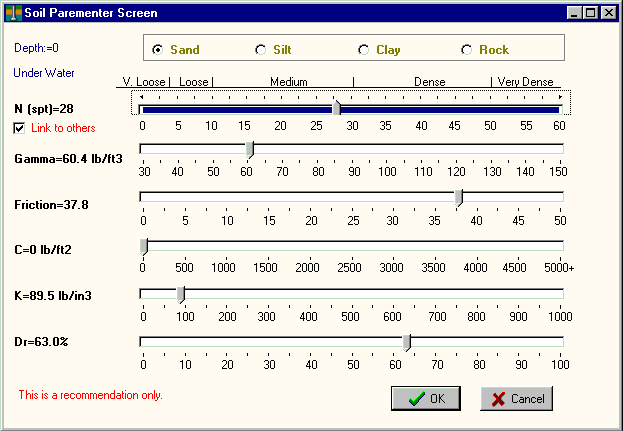
For users with limited field data, they can just select any one of the soil parameters in sliding bars and let the program to find other parameters for them. 
AllPile calculates the section properties for users. It has a built-in database for all available steel piles. 
Group Pile can handle vertical and lateral analysis.
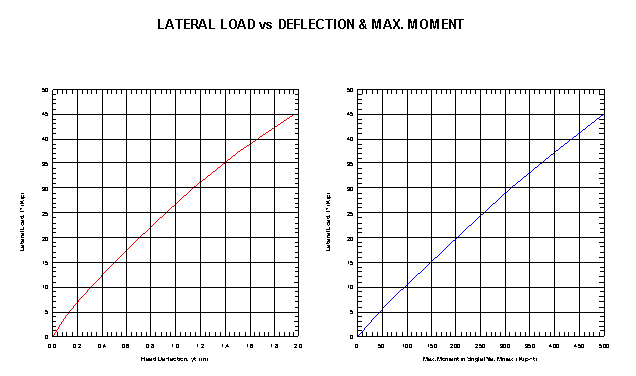
Results Output: Lateral load, and maximum moment vs. pile top deflection. 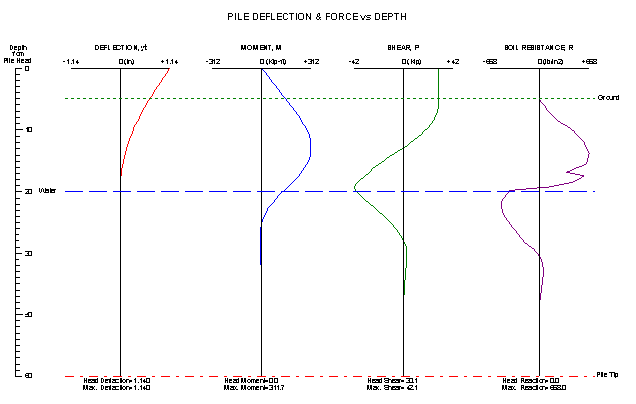
Results Output: Deflection, moment, Shear, and Resistance along pile length. 
Results Output: Uplift, downward capacity vs pile length. 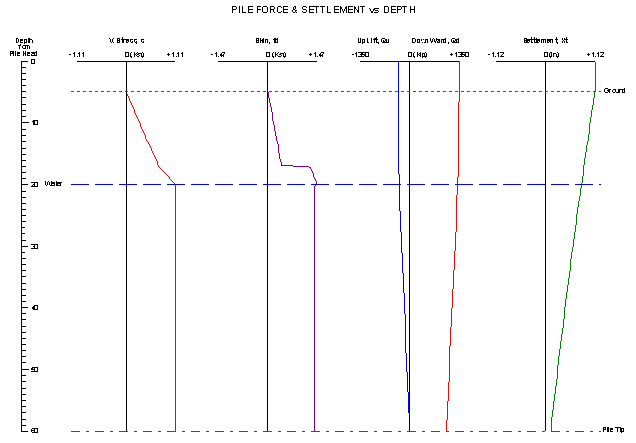
Results Output: Overburden stress, skin friction, uplift, downward, and settlement along pile length.


